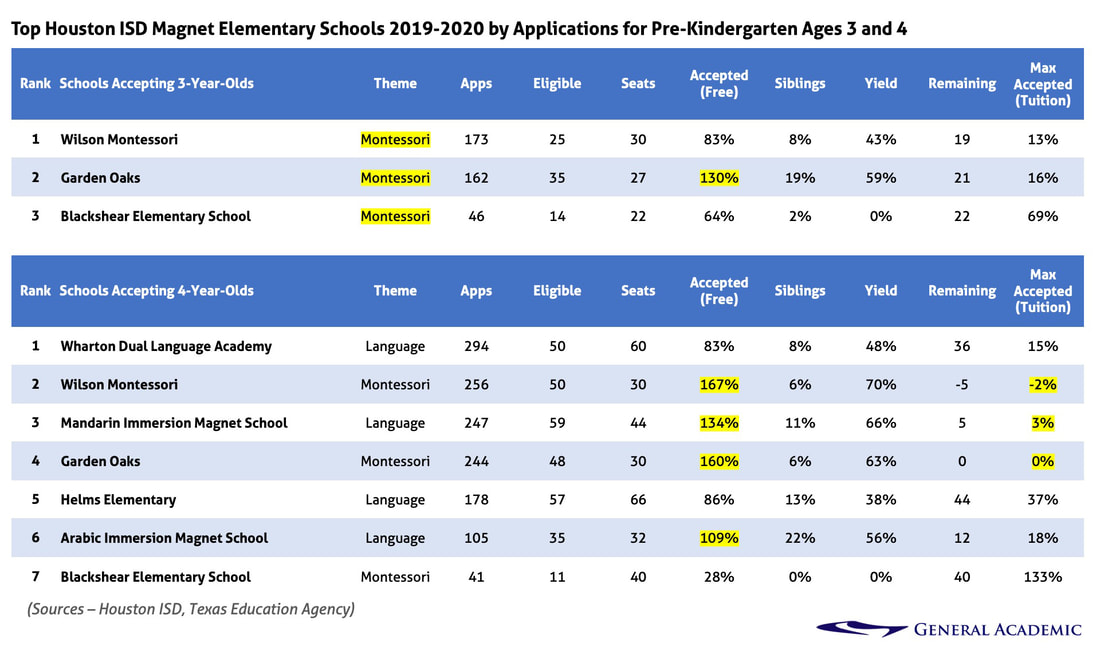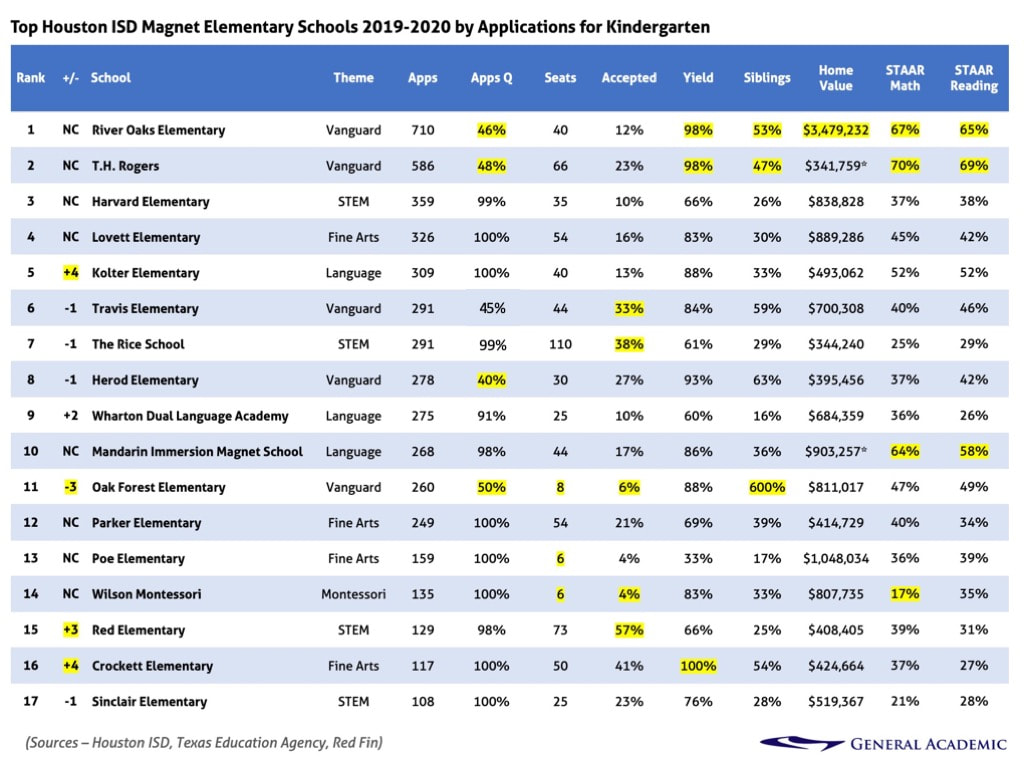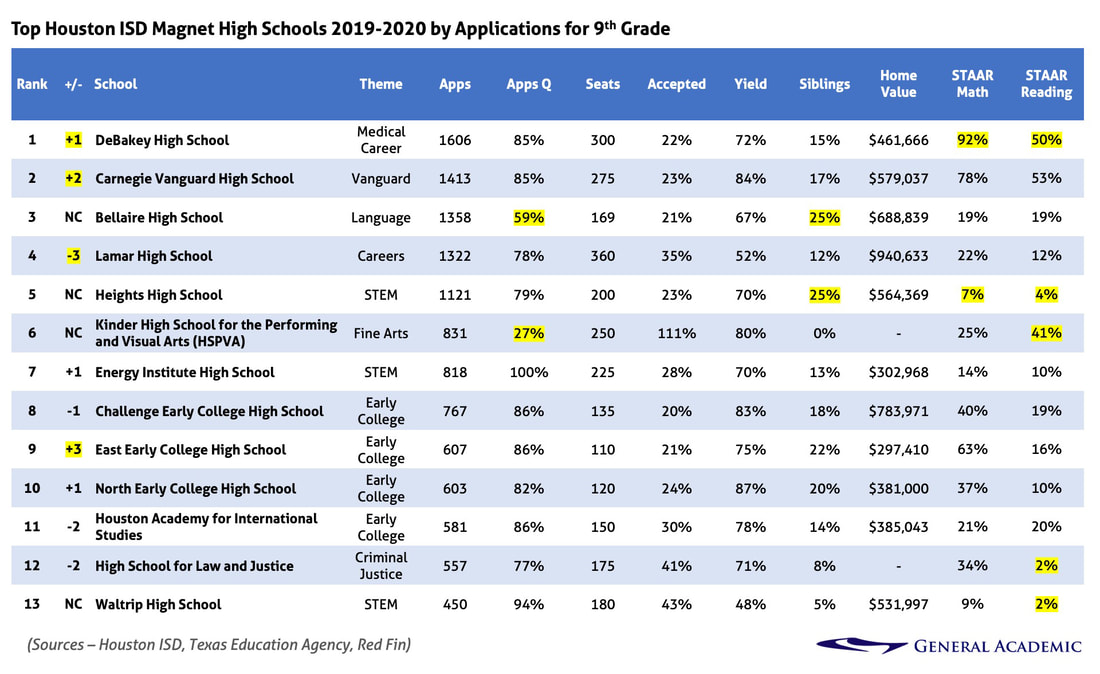
Analysis of School Choice Lottery for 2019-2020
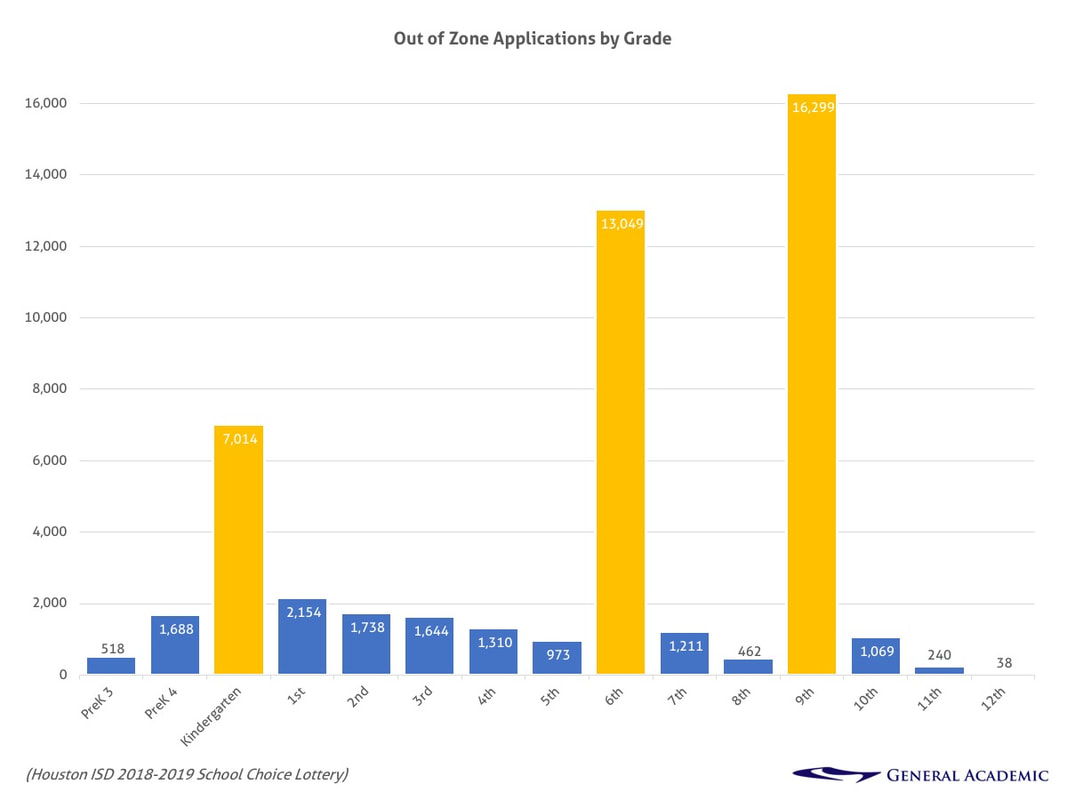 The most popular Houston magnet schools were River Oaks Elementary, Pin Oak Middle School, and DeBakey High School for the 2019-2020 academic year. Families had about a 20%-40% chance of gaining admission to a desirable magnet school for a prime entry year, the year when the most number of seats are available for a given school.
The most popular Houston magnet schools were River Oaks Elementary, Pin Oak Middle School, and DeBakey High School for the 2019-2020 academic year. Families had about a 20%-40% chance of gaining admission to a desirable magnet school for a prime entry year, the year when the most number of seats are available for a given school.
This analysis is for a previous year’s School Choice lottery. For a more current look at Houston ISD (HISD)’s magnet schools, click here.
The prime entry year for most HISD schools is kindergarten for elementary, sixth grade for middle, and ninth grade for high school.
A little less than 9% of Houston ISD (HISD) students participated in this year’s annual School Choice Lottery. 18,092 families submitted an average of 2.4 applications each for a total of 44,165 applications submitted during Phase I of the lottery.
Participation in the lottery was down 13% versus the previous year when 20,711 students submitted 52,123 applications. The decline was most prevalent at 6th grade (-13%) and kindergarten (-9%) but virtually unchanged for 9th grade.
This was the first year that General Academic looked at applications from siblings of currently enrolled students as a measure of a family’s satisfaction with a school. The average HISD magnet school could expect to fill about 15% of its seats with siblings, but the most popular schools could expect 25% or more if space allowed. HISD’s lottery rules reserve up to 25% of available seats just for the siblings of students who are currently enrolled and will continue to be enrolled in the following year.
Summary of Findings
- The top schools are popular among families largely because of their better test results and locations in expensive neighborhoods; however, particularly at the high school level, HISD has worked to reduce the historically inextricable link between family wealth and outcomes.
- Students are only interested in about 30% of the 120 programs on offer as evinced by the low number of applications per student and the clumping of applications around a handful of popular schools.
- Students are not applying to enough schools even though there’s no cost to apply, and students may apply to up to 5 schools. However, the average student only submits 2.4 applications, which unnecessarily limits their chance of admission by at least 50%.
- Families aren’t doing enough to ensure their children meet admissions requirements. At some vanguard schools, more than half of applying students don’t actually qualify as gifted and talented.
- For Pre-Kindergarten, it’s nearly impossible for non-disadvantaged families to enroll in an HISD magnet school.
- For Kindergarten, small classes and the prevalence of neighborhood schools means that the most popular schools are in rich neighborhoods with increasingly few seats.
- For 6th grade, there are fewer desirable schools versus kindergarten and ninth grade.
- For 9th grade, there are a bevy of choices, but the additional options also yield stronger importance to student-fit.
Introduction to the Houston ISD School Choice Lottery
While all students are automatically accepted into the school in their zoned neighborhood, the annual School Choice lottery allows families to apply to schools in other neighborhoods or to special schools that are “equal opportunity” in that none of the students come from the surrounding neighborhood.
The ability to attend an “out of zone” (OOZ) school is particularly appealing if families live in a neighborhood zoned to a relatively poor performing school but cannot afford to spend an average of $3.5 million to buy into or rent in the neighborhood zone of number one River Oaks Elementary for example.
However, parents must pay attention to a school’s unique program and admissions requirements. While some magnet schools enforce no requirements other than families be residents within HISD’s attendance zone, many schools have minimum qualifications such as that students be designated as Gifted and Talented (River Oaks Elementary), have a talented tongue for languages (Bellaire High School), or possess surprisingly good artistic ability (High School for the Performing and Visual Arts). About 30% of applications this year were automatically rejected, because students did not actually meet the qualifications to attend a certain school.
For the 2019-2020 lottery, students could have applied to a maximum of five schools, and they had to rank their schools in order of preference. The rank order did not affect the outcome of the lottery; it only affected how students were placed on a waitlist. If a student was admitted into a school they ranked higher than another school, they would not have been waitlisted at their lower-ranked school. The intended effect of this policy is to shorten waiting lists for all schools.
Parents had to have submitted their applications online or by mail by December 7, 2018, to participate in Phase I of the School Choice Lottery. If families applied to a vanguard school but their children were not already identified as Gifted and Talented, they had until December 9, 2018, to request testing. Families received acceptance letters on March 21, 2019, and had through April 4 to accept the offer of admission.
Qualified applicants are thrown into a randomized lottery. There are generally no ways to gain an advantage other than to:
- Take the necessary steps to be qualified to attend the desired school;
- Already have a sibling enrolled at a school and want to attend concurrently with the sibling next year;
- For pre-kindergarten only, qualify as disadvantaged.
Students may technically apply to most magnet schools up until the first day of school on August 26, 2019. However, applications submitted after Phase I are essentially guaranteed not to place into any desirable school, because all the seats would be already taken. Students will continually move off of the waiting list until August 26, 2019.
How to Read the Tables
- Theme indicates the type of magnet school; parents can learn more about the different themes at HISD’s website
- Apps refers to the number of applications received from out of zone (OOZ) students and excludes zoned neighborhood students
- Apps Q is the percentage of OOZ apps that are actually qualified to be considered for admission
- Seats is the number of spaces available to OOZ students and excludes availability for zoned students
- Accepted is the percent of qualified applicants offered admission on March 21, 2019
- Yield is the percent of applicants who had accepted their offer of admission by April 5, 2019
- Siblings is the percent of OOZ applicants from siblings of currently enrolled students
- Home Value is the average listing price of homes in the school’s neighborhood zone or immediate vicinity
- STAAR Math is the percent of all students at the school who earned the “Masters” designation on the STAAR math tests
- STAAR Reading is the percent of all students at the school who earned the “Masters” designation on STAAR reading tests
- HISD presented this data as accurate on April 5, 2019, but the numbers will change continuously until school starts on August 26, 2019, as students finalize their enrollment plans
Additional Details for Pre-Kindergarten
- Eligible is the number of applications from eligible, disadvantaged students who receive free tuition and priority
- Accepted (Free) is the percent of eligible students who were offered admission on March 21, 2019
- Remaining is the maximum number of seats that might be available to tuition-paying students
- Max Accepted (Tuition) is the best-case scenario chance of admission for a tuition-paying student
Top Houston ISD (HISD) Magnet Pre-Kindergarten Schools
There were 3 magnet schools that accepted 3-year old students, and 7 magnet schools that accepted 4-year old students. However, admission priority at pre-kindergarten is strongly for disadvantaged families, and for these students there is no tuition to attend.
In the event that all disadvantaged students have accepted admission by May 31, 2019, and space remains, students from non-disadvantaged families may enroll and pay tuition of $5089. Note however that preschools must retain 5% of the originally available spaces through August 26, 2019 (the first day of school), in the event that an eligible, disadvantaged student later decides to attend.
At age 3, interested, disadvantaged students were essentially guaranteed admission at Garden Oaks and Wilson Montessori. There is a small chance of admission for tuition-paying students at Wilson Montessori, Garden Oaks, and Blackshear.
At Garden Oaks Montessori, 35 qualified students applied for 27 seats, and 59% of offered students had agreed to enroll. Assuming that the yield rate remains unusually low at 59% for all 35 qualified applicants, and no other eligible students apply before school starts on August 26, 2019, that would mean that as many as 11 seats would be available for the estimated 127 tuition-paying students or a 7% chance of admission.
At Wilson Montessori, 25 qualified students applied for 30 seats, and 43% had accepted offers of admission. Therefore, there may be as many as 19 seats available for the 148 tuition-paying students or a 13% chance of admission.
At age 4, admission was nearly guaranteed for disadvantaged students at Wilson Montessori, Mandarin Immersion, Garden Oaks, and Arabic Immersion. For tuition-paying students, the chance of admission is best at Wharton, Helms, Arabic Immersion, and Blackshear; there is virtually no chance of admission at Wilson Montessori, Mandarin Immersion, and Garden Oaks.
Top Houston ISD (HISD) Magnet Elementary Schools
For the 2019-2020 academic year, 2,548 students submitted 6,491 applications for kindergarten to 58 HISD magnet elementary schools.
 River Oaks, TH Rogers, and Harvard elementaries retained their titles as the most popular choices. Qualified families had an average of 20% chance of getting into one of the top schools.
River Oaks, TH Rogers, and Harvard elementaries retained their titles as the most popular choices. Qualified families had an average of 20% chance of getting into one of the top schools.
While there were 2,284 kindergarten seats open in total, the 17 most popular schools received 78% of the applications and had 753 seats available for an average acceptance rate of about 20% or 5 qualified applications per seat. With few exceptions, students are excited about attending these schools as nearly 80% of families quickly accepted their offer of admission.
These popular elementary schools are objectively good when measured by their STAAR test results. On average, 40% of students at these schools are scoring at the highest, “Masters” level on the STAAR reading and math tests, which is nearly twice as good as the district average of 21%.
Families at these schools seem very happy. These top elementary schools have exceptional “loyalty rates” as measured by the percentage of applicants coming from families who already send a student to the school. While only 25% of available seats are specifically reserved for siblings of currently enrolled and continuing students, on average 35% of the seats could potentially be filled with only siblings at the top schools (the average across all HISD prime entry grades is 16%). At the most popular elementary schools like River Oaks, Rogers, and Herod, siblings could potentially fill up as many as 60% of the available seats.
Several schools made big jumps in popularity versus last year’s lottery. The Arabic Immersion Magnet (not in the top 17) moved up 5 spots followed by Kolter (+4), Crockett (+4), and Red (+3). Oak Forest fell 3 spots, which is appropriate given that its limited availability makes for an essentially wasted application (families may have applied to a maximum of 5 schools).
Students lucky enough to attend these schools also get to enjoy posh surroundings and classmates from the zoned neighborhood. The average home listing price around the top schools is a jumbo $768,230; by comparison the homes that feed into #57 Ross Elementary are listed for an average price of just $69,273.
West University, Roberts, Twain, and Bush Elementaries are not part of the magnet lottery, because they can barely accommodate their zoned, neighborhood students let alone out of zone transfers.
Several more elementary schools in rich neighborhoods are set to lose their magnet status due to full enrollment from their zoned neighborhoods. Garden Oaks Montessori accepted 160 applicants this year but had zero seats to give them. Oak Forest, Poe, and Wilson Montessori had fewer than 8 seats available, which amounted to acceptance rates of less than 5%.
Top Houston ISD (HISD) Magnet Middle Schools
For the 2019-2020 academic year, 4,361 students submitted 11,431 applications for 6th grade to 34 HISD magnet middle schools.
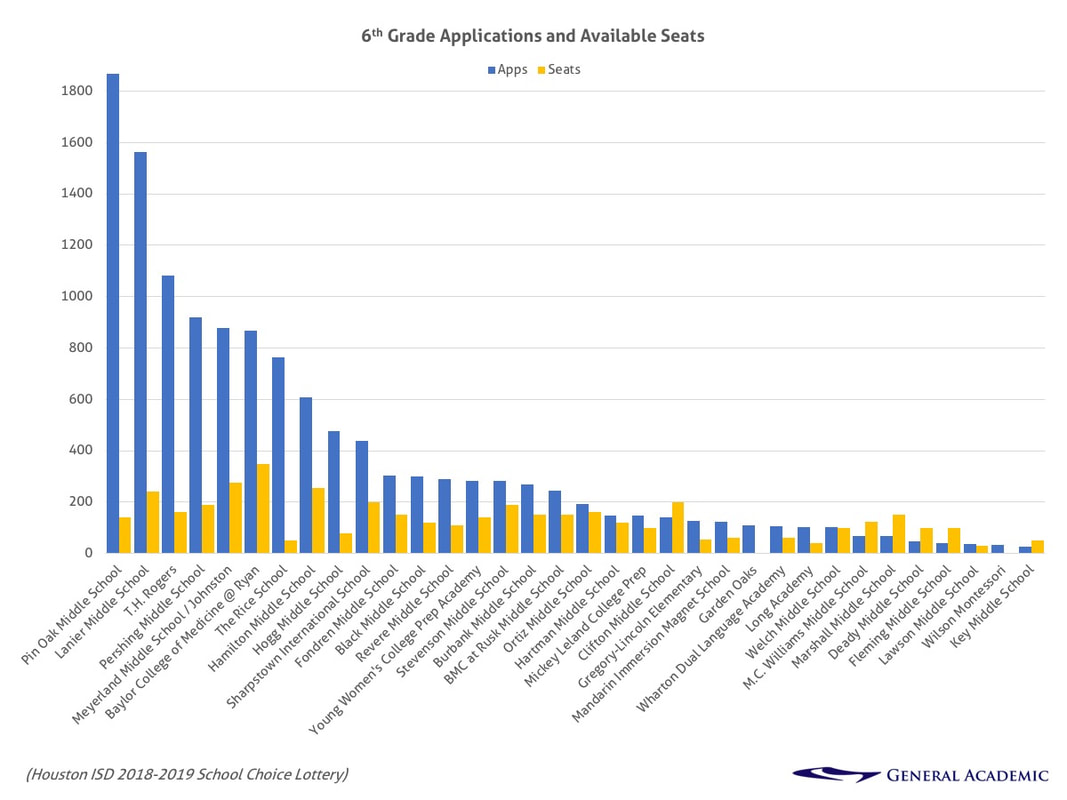 Pin Oak, Lanier, and T.H. Rogers middle schools retained their titles as the most popular choices. Qualified families had about a 40% chance of getting into a top middle school.
Pin Oak, Lanier, and T.H. Rogers middle schools retained their titles as the most popular choices. Qualified families had about a 40% chance of getting into a top middle school.
While an overall of 3,915 sixth grade seats were available, the 9 most popular middle schools received 69% of the applications and had 1,473 seats available for an average acceptance rate of 40%. Students seem eager to attend these schools as 78% of families quickly accepted their offer of admission.
These popular middle schools are objectively good when measured by their STAAR test results. On average, 40% of students at these schools are scoring at the highest, “Masters” level on the STAAR reading tests, and 27% are earning the Masters designation on the STAAR math tests, which is up to twice as good as the Houston ISD average of 21%.
Families at these middle schools seem happy. These top 9 schools have high “loyalty rates” as measured by the percentage of applicants coming from families who already send a student to the school. On average 19% of the seats could potentially be filled with only siblings at the top schools, compared with less than 7% for the less popular schools. Pin Oak Middle School stands alone with the ability to fill as many as 42% of its available seats with siblings (although only 25% are automatically reserved according to HISD’s magnet lottery rules).
Houston ISD’s middle schools are more diverse than its elementary schools, which are mostly populated by zoned neighborhood students. Since no neighborhood students are technically zoned to them, Pin Oak and T.H. Rogers in particular are “equal opportunity” as nearly every single seat is available to a student participating in the lottery. These perennial favorites have the added benefit of being located in rich neighborhoods. Baylor College of Medicine at Ryan Middle School was formerly an all-lottery school as well; however, it began accepting neighborhood students in 2018.
Top Houston ISD (HISD) Magnet High Schools
For the 2019-2020 academic year, 5,946 students submitted 16,659 applications for 9th grade to 39 HISD magnet high schools.
 DeBakey assumed the top spot for the first time followed by Carnegie Vanguard and Bellaire High School. Qualified families had about a 34% chance of getting into a top high school.
DeBakey assumed the top spot for the first time followed by Carnegie Vanguard and Bellaire High School. Qualified families had about a 34% chance of getting into a top high school.
While an overall of 5,752 ninth grade seats were available, the 13 most popular high schools received 72% of the applications and had 2,649 seats available for an average acceptance rate of 34% or nearly 3 applications per seat. Students seem happy to attend these schools as 72% of families quickly accepted their offer of admission.
The top 13 schools produce STAAR test results nearly twice as high as HISD as a whole. On average 20% of students scored in the top “Masters” tier on the STAAR reading test versus 10% for HISD. In math, 35% scored in the top “Masters” tier versus 20% for HISD as a whole.
However, high academic results do not always appear to be the best predictor of a high school’s popularity. In particular, Heights High School, High School for Law and Justice, and Waltrip High School stand out for their comparatively low STAAR scores.
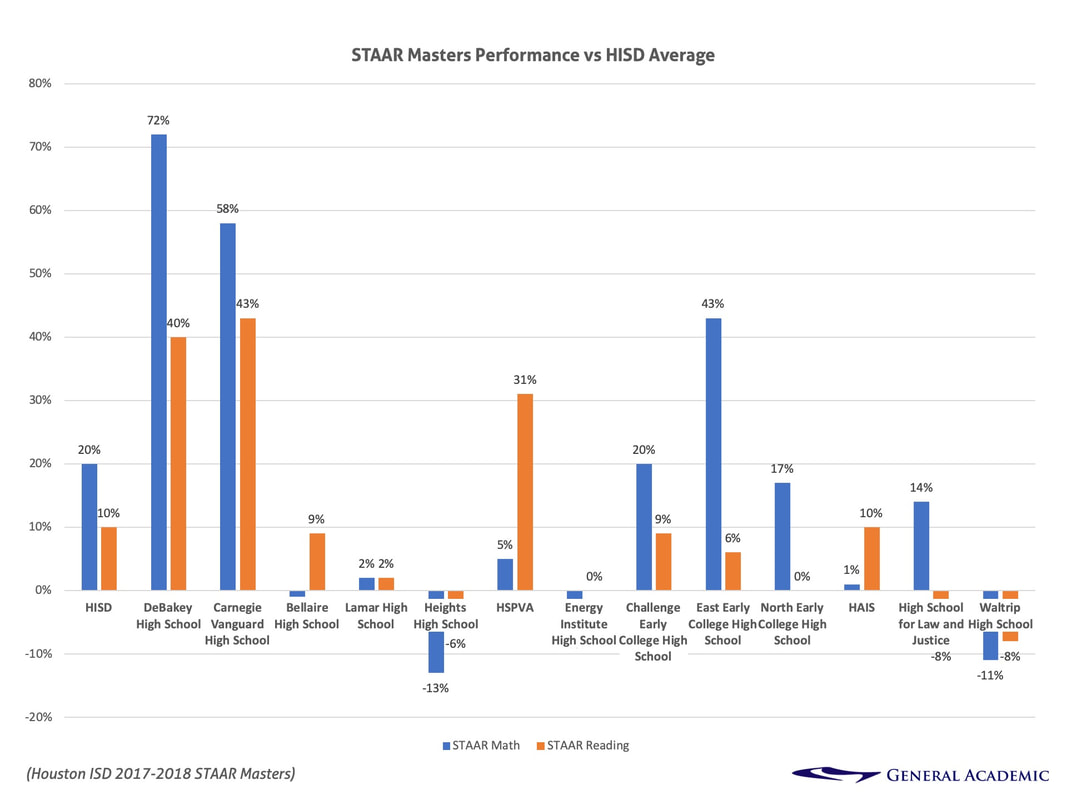 Compared to elementary and middle schools, top HISD magnet high schools seemingly put a stronger emphasis on math; the percentage of students earning the highest STAAR “Masters” scores are nearly double that of Reading. The best high schools by math STAAR scores are DeBakey (92%), Carnegie Vanguard (78%), and East Early College High School (63%). The one exception to this trend is HSPVA, where reading scores (41%) exceeded math scores (25%).
Compared to elementary and middle schools, top HISD magnet high schools seemingly put a stronger emphasis on math; the percentage of students earning the highest STAAR “Masters” scores are nearly double that of Reading. The best high schools by math STAAR scores are DeBakey (92%), Carnegie Vanguard (78%), and East Early College High School (63%). The one exception to this trend is HSPVA, where reading scores (41%) exceeded math scores (25%).
Similarly, families are less loyal to magnet high schools; the higher differentiation between academic programs probably plays the biggest factor. On average only about 15% of seats are filled by siblings, which is double the 8% average of all magnet high schools but mostly equal to the average across all HISD schools at prime entry grade. In this regard, Bellaire and Heights High Schools stand out with their 25% of applicants coming from the siblings of currently and continuing enrolled students.
As to be expected for the diversity represented by the US’s 7th largest school district, many of Houston ISD’s top magnet high schools are increasingly differentiated, and a school’s recruiting efforts tend to target specific communities. For example, during the 2017-2018 school year, HSPVA’s student population was 44% white (400% more than the HISD average), and only 19% economically disadvantaged (75% less). Conversely, East Early College High School was 94% Hispanic (52% more vs HISD) and 84% economically disadvantaged (12% more vs HISD).
 Lamar High School fell three spots and received 23% fewer applications versus the 2018-2019 lottery. However, its 2018 end of course (EOC) STAAR results were up across the board; it saw its biggest gain in Algebra I, where 24% of students earned the “Masters” designation versus 18% in the previous year. Similarly, Advanced Placement (AP), International Baccalaureate (IB) rates, and SAT scores are up.
Lamar High School fell three spots and received 23% fewer applications versus the 2018-2019 lottery. However, its 2018 end of course (EOC) STAAR results were up across the board; it saw its biggest gain in Algebra I, where 24% of students earned the “Masters” designation versus 18% in the previous year. Similarly, Advanced Placement (AP), International Baccalaureate (IB) rates, and SAT scores are up.
The River Oaks-area school’s new $129 million expansion is on track to open in time for the 2019-2020 school year. The former Dean of Magnet Students at popular Pin Oak Middle School became Principal in 2018. Therefore, the most plausible explanation for the decline in popularity was the daytime murder of a student on November 24, 2018, just outside of Lamar’s campus. Houston police arrested a gang member on March 8, 2019, for that student’s murder.
When measured by SAT scores, Houston’s top high schools are DeBakey, Carnegie, and HSPVA; the very high average scores at these elite schools place their students in the top 10% nationally.
Carnegie Vanguard and DeBakey are both nationally ranked by US News and World Report. Carnegie ranks #24 (down from #8 last year), and DeBakey ranks #17 (up 1). Additionally, Eastwood Academy is ranked #97, but it does not participate in the School Choice Lottery; interested candidates must submit their application for holistic review to the school in person.
Diversity at Houston’s Top Magnet High Schools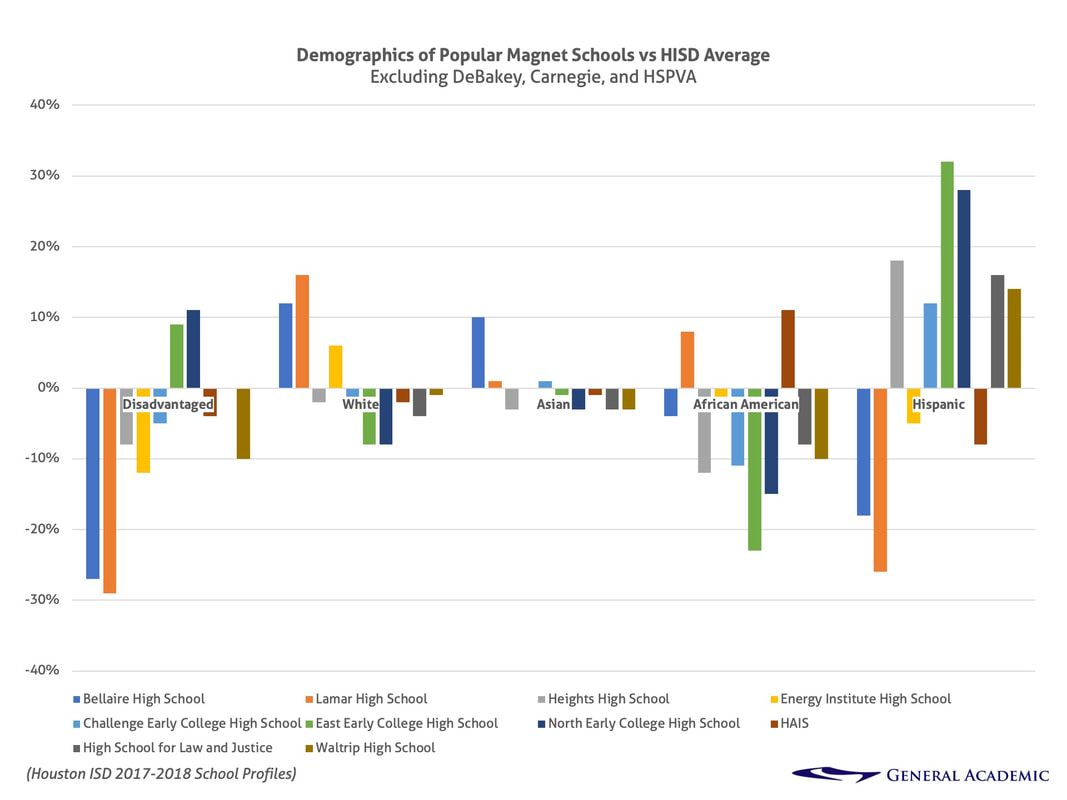
For public school districts with magnet schools, there is always a concern that the magnet student populations do not accurately represent the demographics of the district as a whole or that they are inequitable in how they enroll students.
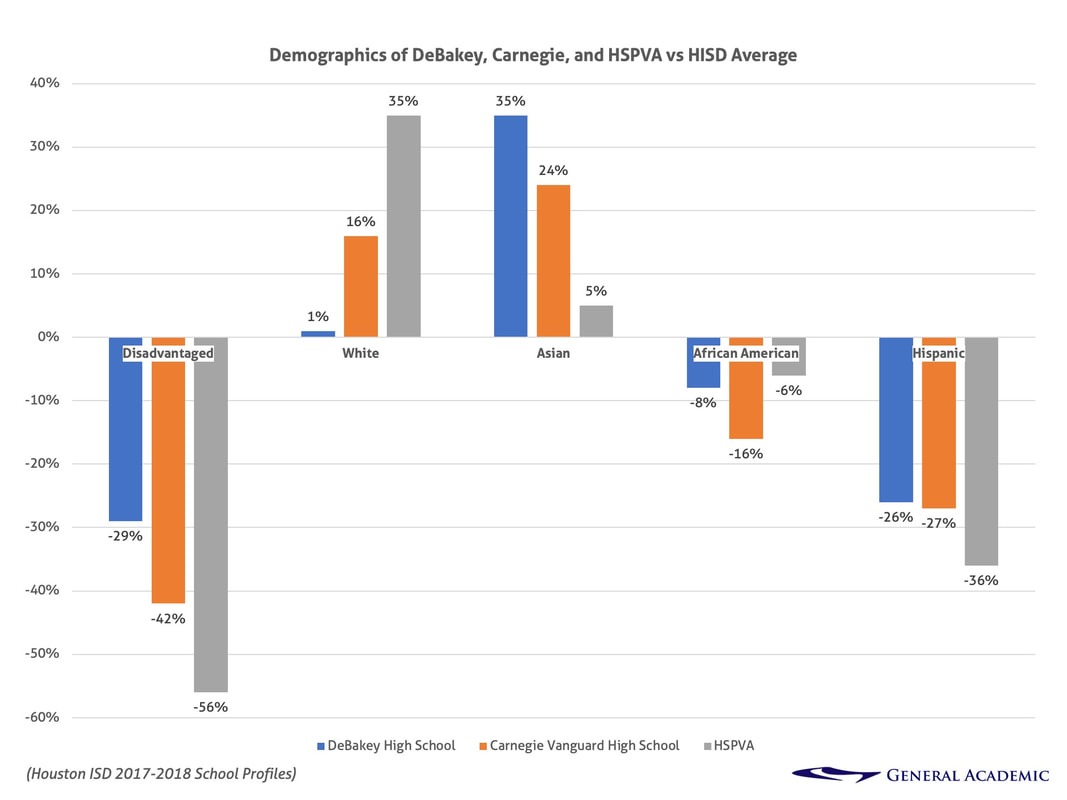 For the 13 high schools that received more than the average number of applications during the School Choice Lottery, these are the average demographics (group vs HISD as a whole):
For the 13 high schools that received more than the average number of applications during the School Choice Lottery, these are the average demographics (group vs HISD as a whole):
- Economically Disadvantaged – 59% vs 75%
- Asian/ Pacific Islander – 9% vs 4%
- African American – 17% vs 24%
- Hispanic – 60% vs 62%
- White – 14% vs 9%
If only DeBakey, Carnegie, and HSPVA are considered:
- Economically Disadvantaged – 33% vs 75%
- Asian/ Pacific Islander – 25% vs 4%
- African American – 14% vs 24%
- Hispanic – 32% vs 62%
- White – 26% vs 9%
The School Choice Lottery does not give any preference based on demographics. Nonetheless, for lottery applicants, HISD asks if a student is Hispanic. For the 2019-2020 phase 1 lottery, there were 8,605 students who self-identified as Hispanic or about 48% of the total.
—
For more than 15 years, Rice Village-based General Academic has provided tutoring, test preparation, and consulting services in addition to producing publications like this one.
This analysis is based off of data acquired from HISD through the Texas Freedom of Information Act and looks specifically at the numbers available on April 5, 2019; the number of seats available will continue to change until the school year begins in August.
Other sources include the Texas Education Agency and RedFin.
Click here to download the original dataset (Microsoft Excel) provided by HISD.
This article was last updated on 5/3/2019.
